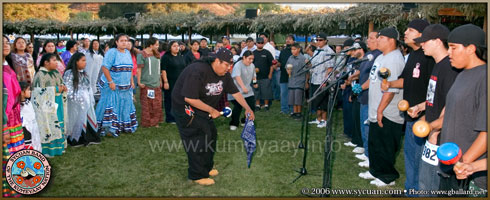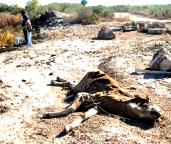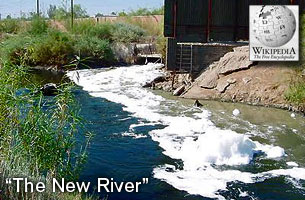
Para Español Traduzca esta página inglesa al español
Webmaster Forward:
I am just beginning this section on the Cocopah Indians tribe and Cocopah Indian tribal history (NOV 05).
Of course, as I know almost nothing about the Cocopahs, my writing about them may appear goofy for some time, at least until I get some help, or I plug away at it long enough — so as to not misrepresent the Cocopah Nation too badly as I learn on the job — my apologies in advance.
PLEASE VISIT THE OFFICIAL WEB SITE of COCOPAH INDIAN TRIBE of SOMERTON ARIZONA. NOTE: KUMEYAAY.INFO Cocopah information is "not official, or endorsed, or authorized" by the Cocopah Indian Tribe of Somerton, AZ. Please visit www.cocoph.com for official Somerton tribal information, news, and culture.
COCOPAH RESORT Casino & Conference Center
KUMIAI DE BAJA CALIF MEXICO en Español Kumiais una cultura en riesgo de extinsión, Acerca de los indigenas Kumiai, Geografia, Sistema Politico, Origenes lingüisticos, Programas de Trabajo, Consejo, Acerca de los indigenas Kumiai, Gobernadora Kumiai, Origenes lingüisticos
y mucho mas...
COCOPAH CUCAPA COCOPA
The Cucapá call themselves Chaipei Ñuogua Ñuyiu, Juañal (people who come and go, Indians).
Today's Cucapa Indians mainly inhabit three communities — one near Somerton, Arizona, another at Ejido Pozas de Arvizu, near San Luis Rio Colorado, Sonora, and El Mayor Cucapá Indigena, Baja California, on the Mexicali - San Felipe highway.
The Cocopah people are Native American Indians indigenous to Southern California, northern Baja California, Mexico, and southwest Arizona. The Cocopah Indians research shows the Cucapa Indinos are part of the Yuman Indians, and their language is based on the HOKAN languages of southwest USA.
The Cocopah Indian Tribe of Somerton, AZ, is a SOVEREIGN NATION.
My own experience with the Cocopah tribes began in 2004 when I visited El Mayor, Baja California, Mexico, to do some documentary video work for a friend, and I was greatly touched by the environmental tragedy there on the RIO HARDY — how the lack of water, the poisoned water, is devastating wildlife and the lives of the Cucapa Cocopah Indigenous people, the Cucapa aboriginal fishing village there: "Fighting Over the Last Drops as Colorado River Reaches Its End" CNN-AP rioweb.org.
It was on this trip to the Baja fishing village that I photographed the above photo of this Mountain from the road. I later replaced the original setting tribal sun with a rising moon, and colorized the sky for a pretty moon-rise effect (instead of the original Indian sunset which was too bright).
I am also including several video JPEGs in this photo gallery portfolio of river people, their evironmental lifestyle pictures from my 2004 trip to El Mayor for a Kalim Smith multimedia video production — I now regret not shooting more stills on this trip, but at the time I was still shooting traditional film.
KUMEYAAY.COM writer Mike Wilken (link broken) writes some very interesting information about the El Mayor community.
COCOPAH BIRD SINGING MUSIC

Click on Yuman Indian picture for high-resolution pictures of indigenous Colorado River area Indians of North America.
COCOPAH TRIBAL BIRD SINGERS today still sing the tribal bird songs of the Yuman peoples and generally accompany their Native singing with shaking hand-held Indian GOURD RATTLES while Cocopah bird dancers join in — click "Audio" thumbnails (in left column) hear 2005 audio clips of Cocopah singers Dale Phillips and Heraclio Tambo.
For an audio recording video movie documentary excerpt of Cocopah cultural singers, please see KUMEYAAY.INFO FREE ONLINE MUSIC VIDEO that features singers Dale Phillips, Cocopah, Onesimo Gonzalez Sainz, Cucapa, and Kalim Smith, Creek Indian, singing Cucapa songs on the Rio Hardy River bank near El Mayor, BC, Mexico, 2003.
EL MAYOR, Cucapa Indian Village, Baja California, MexicoWhen Onesimo Gonzales, the (Cucapa) village chief, was born in 1934, Hoover Dam was just taking shape and the Colorado River was untamed. The (Colorado River) delta (area) then supported a marshland and silt-rich estuary covering 1.9 million acres. "The river was everywhere and nowhere, for (it) could not decide which of a hundred green lagoons offered the most pleasant and least speedy path to the gulf," traveler Aldo Leopold wrote in 1922. Eighty years ago Leopold wrote of "awesome jungles... lovely groves... still waters of a deep emerald hue." He described (the area as) an Eden alive with colorful birds of every size, deer, bobcats and coyotes. Chief Onesimo Gonzales explained (2001), "Our river is gone. No more fishing. Trees are dead. No one plants. The wells are dry." The 45 remaining families coax murky water for washing from a distant (well), but for drinking or cooking they wait for trucks that sell clean water... the plight of El Mayor typifies what is happening around the world.... -Published 2001, CNN AP EXCERPT Archived Story |
THE NEW RIVER
Poisoning Humans, Plants and Wildlife on the Colorado River Delta, Gulf of California
The NEW RIVER at the International Boundary, is pictured above carrying foam and mixing with wastewater from the International Drain on its journey up from Mexico and on to the Colorado River, Rio Hardy, Gulf of California, Sea of Cortez, Mexico.
The NEW RIVER flows north from the city of Mexicali, Baja California, Mexico into the United States through the city of Calexico, California. The river has been referred to as the most severely polluted river of its size within the United States.
As anyone who has ever gotten close to this stinking waterway will attest, the small canal-like waterway smells like an open sewer, raw sewage stench — even miles downwind in local communities on both sides of the US-Mexico border towns and farm lands — the smell is unbearable.
RIO HARDY RIVER
Downstream...
By comparison the same is happening to the RIO HARDY.
The Hardy River has become a drain for agricultural waters polluted with pesticides and fertilizers from the Mexicali Valley.

Above photo, a dead cow is pictured on a receded river bank of Rio Hardy showing an ecosystem in distress, its wetlands and plant life are dead and dying for lack of water.
Water quality in the River Hardy is being monitored at Mexicali by the Centro de Investigacion en Alimentacion y Desarrollo A.C. to measure the effects of discharge on the waterway from the Las Arenitas wastewater treatment plant.
PLEASE SEE ECOLOGICAL REPORTS and NEWS ARTICLES about alarming OVER FISHING, POLLUTION, TRIBAL HUMAN RIGHTS, URANIUM-RADIOACTIVE WASTE found in tribal Native American lands and water.
COCOPAH INDIAN RESEARCH
• COCOPA INDIAN TRIBE HISTORY accessgenealogy.com:
-
"COCOPA (ko'-ko-pa). A division of the Yuman family which in 1604-05 lived in nine rancherias on the Rio Colorado, five leagues above its mouth...According to Heintzelman, in 1856, the tribe was formerly strong in numbers and could muster 300 warriors; their total number was estimated by Fray Francisco Garcés in 1775-76 at 3,000, but there are now only 800 in north Lower California, in the valley of the Rio Colorado. The Cocopa were reputed to be less hostile than the Yuma or the Mohave, who frequently raided their villages; nevertheless they were sufficiently war-like to retaliate when necessary...".
-accessgenealogy.com
Terms of Use • Privacy Statement • Site Map • Kumeyaay Indians Research



